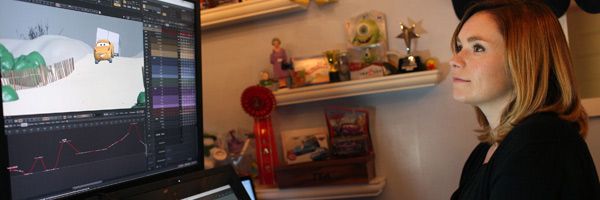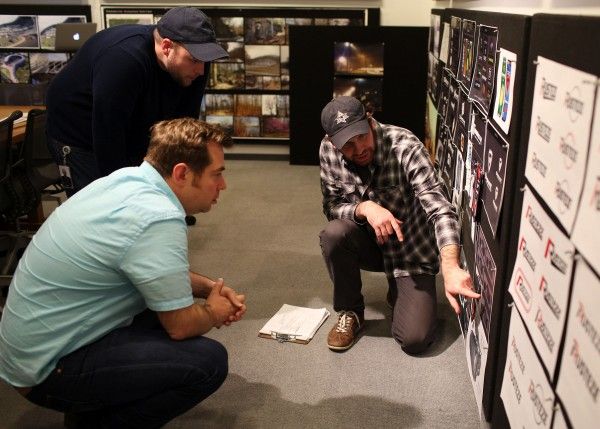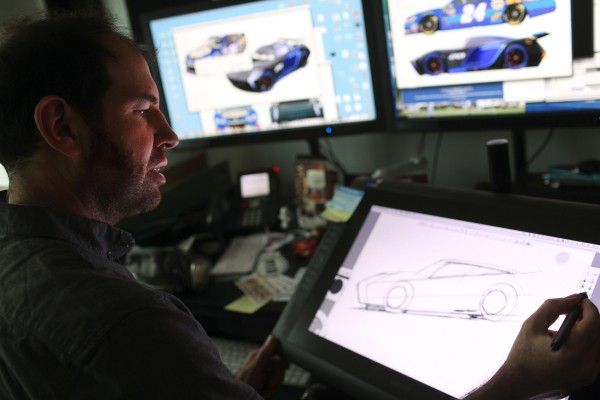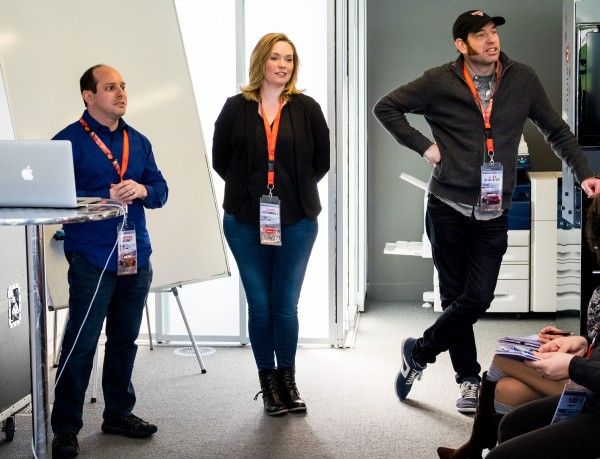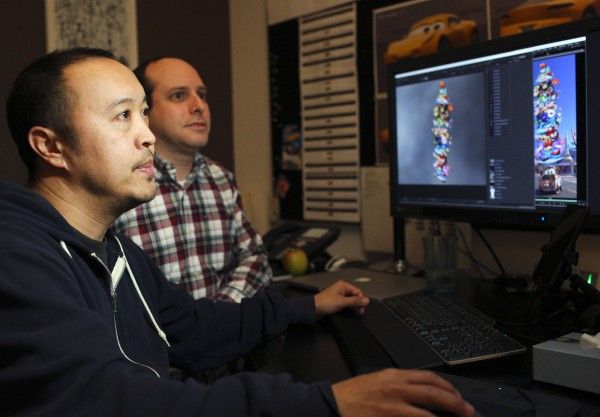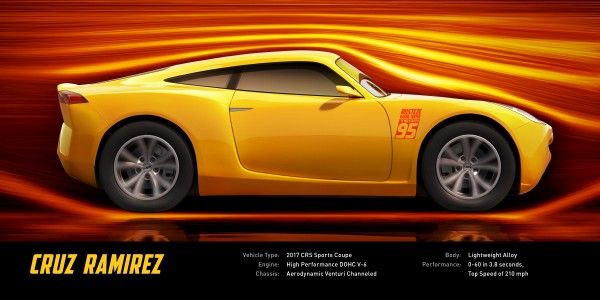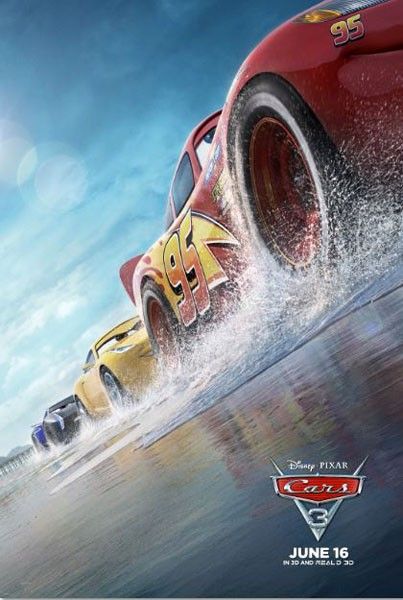Four years ago, I got the incredible opportunity to visit Pixar in Emeryville, Calif. for the first time, to do interviews for Monsters University, and the thing that most stood out to me when I was there was just how much inspiration you feel, surrounded by all of the artistic creativity going on within its walls. Saying that I was excited to return, this time to get an early look at nearly 45 minutes of Cars 3, is a massive understatement.
As part of the experience, Collider got to spend the day at the Sonoma Raceway, participating in presentations about how the story, production design, animation and effects all came together to create what we’ll get to see in theaters on June 16th, as well as getting the opportunity to take a lap around the racetrack and go through pit stop training. We were also able to sit down with directing animator Jude Brownbill, characters supervisor Michael Comet and production designer Jay Shuster to chat about their specific involvement with Cars 3, the challenges in giving personality and humanity to cars, the fun of creating new characters, making the technology work to their advantages, the evolution of Cruz from a male character to a female character, and how cool it is to get to see merchandise and life-size versions for characters they have a hand in creating.
Collider: How did you come to be a part of Cars 3, and what was your involvement with the project?
JUDE BROWNBILL: I came to the project just over a year ago, and I’m a directing animator. I worked on Cars 2, and a bunch of other films, before this one. On Cars 2, I was an animator. On this one, as a directing animator, there’s probably between 60 and 70 animators that work on the whole film. With that many people and that many hands on each of the characters, the directing animators are there to make sure that the animators have all the information they need to animate those characters in the way that keeps that on model, so that they don’t change shape throughout. I try to be a voice for what we learn from Brian [Fee], to help them get their voice on the screen for him.
JAY SHUSTER: I got my job at Pixar on the first Cars film, and I worked on Cars 2, so it just made sense that I worked on Cars 3. I came into Pixar with a skill set of designing hard surface characters, like cars or robots and such. Being the third time out, I was able to step up into the production design role, which is the highest tier of the art department, where you’re actually running an art department. I actually shared the production design role with another guy, named Bill Cone, and his group was responsible for all of the environments while my group was responsible for all of the characters. It was definitely a step up in responsibility.
MICHAEL COMET: I was character supervisor with a cohort of mine. My primary focus was more on the modeling and rigging side, rather than on the shading side. For me, it was all about working with art and animation. We have a rigging lead and a model lead that helps to develop a lot of the technology. We talk with them and help to guide the department, as far as how we’re gonna solve problems on the film, the kind of technology we’re going to need, and what our process is going to be. And then, we schedule how things are actually going to line up, so that we can deliver our models and characters to the departments for layouts and animation.
There are people who really love their car and who name them, essentially giving them their own personality, but what are the challenges in giving personality and humanity to cars in an animated film?
SHUSTER: Good question!
BROWNBILL: The hardest thing is to make it believable. You don’t want people to be watching a film and be like, “That's a talking car!,” or “Why are his eyes in his windshield instead of his headlights?” But all of the decisions that are made in service of the story are just to try to be convincing, believable and relatable, so that the cars just read like another character, and like a human being could be in that situation.
SHUSTER: It does start with story and the people who are actually writing the dialogue. It’s written as if it’s a human character, first and foremost, and then we just apply the facade of a car. There are moments in the first Cars film, when I was watching the interaction between McQueen and Sally and Sally was saying, “Are you really gonna do that for Mater?,” and was calling McQueen out, and you’re engaged in this moment. And then, you realize that it’s cars talking to each other. First and foremost, you’re drawn in by who the characters are. The fact that they’re cars should just disappear. It really shouldn’t matter.
COMET: It’s about the mannerisms and the acting that’s coming forth. That’s what you’re really looking at. On the other side, you make sure that there’s nothing that’s going to detract. Nothing should be too shiny, too reflective, or move in a funny way, so that you’re not distracted, as you’re watching.
Is it easier when there were two other movies that came before the movie you’re working on, or is it more challenging because there are two other movies?
COMET: In some ways, it helps. In our case, for the model rigging, we have characters that we can bring over already. We have those models that are done. We also know how we have to rig them because we have a lot of that history. So, it’s really just a matter of converting them over to the new software. That allows us to really work on the new characters and do the new development, and really focus on that.
SHUSTER: With designing the environments and the characters, alike, it does help to have these two movies preceding us, really making up the instruction manual for what to do, going forward.
BROWNBILL: There were a lot of discoveries made on Cars, in terms of how to treat them. When you put two eyes in a windshield and you need to have lids, so that they can blink, and a brow, so that they can have emotions, but if you just do that with the top part of a car and have a twisted brow, it breaks the illusion that it’s a vehicle because, true to the materials, it looks wobbly and wrong. We figured out that we could treat the lids like brows and do that with the lids. There were rules that were already in place, that were discovered in Cars and used again in Cars 2. For the animators, it’s great when you have those rules ‘cause you can just play within those rules.
You have some new characters in Cars 3 that have so much personality that it would be easy to see how they could get their own movie with their own story to continue telling. How is it to create these new characters and have them blend in with the world that you already have, and also have them bring their own personality?
BROWNBILL: It’s a lot of fun. A lot of character discoveries were made on those first two films, so to have that world and structure, and then these brand new characters, that’s where we can play and explore. Those voices give personality to those characters, and then we can design, shade, model and animate them to support who those characters are. That’s where we really get to have a lot of fun.
SHUSTER: It validates how complete those other two movies are. Those characters and environments are so fleshed out, to the best of our ability, at that time, that we really figured it out. Because of that, we were able to really have a good time on Cars 2, and then really just plug and play on Cars 3, and just insert an amazing story.
COMET: I think the new characters are just a lot of fun ‘cause that’s where the challenge is. You get to figure out the design process and what the designs are. On the technical side, we can make the shading look even cooler than before, and add all of this details and richness to it. We have micro-scratches on the surface of the car, that we never had before. When you wash your car, sometimes you leave little scratches on the surface, and we’ve even added that level of detail in. For us, it’s finding out who that character is and who that personality is, and then bringing that to fruition, from design, all the way to rigging.
When the technology changes so much, even from the first movie, do you ever wish you could go back and change anything?
COMET: Sure, yeah. That’s our opportunity now, on Cars 3, to make it look even cooler.
How do you find a way to make the technology work to your advantage?
COMET: We have a big pool of really good talent, of technical development people, at Pixar. We have a whole separate building, where most of the people in there are doing a lot of technical work and proprietary software. It almost is a separate software development, but we’re working with them, in conjunction. It’s all about the communication and collaboration for what the film needs, to really drive all of that development. It’s all in service of the story and what the artist needs. Sometimes it comes from the artist themselves, who wants to do X, Y and Z. Early on, we decided that we were going to put the shading information that you see in the final computer, into Presto for the animators, so that they could see, visually, how that looks. Originally, we were only going to do that for a couple of the cars, but once the animators got ahold of that, they were like, “This is fantastic! It’s helping me to pose the character and really see how it’s going to look, further on, in the rendering process.” So, we ended up doing that for pretty much every character on the film. We wrote a whole technical pipeline to support that, during Cars 3.
Was there any type of car you wanted to do but couldn’t because it just didn’t work?
COMET: That’s a great question!
SHUSTER: Yes! Fritter went through a few different iterations. She started life as a school bus, but then, as we do with these character designs and most things with story, we push it around and we change it, just to make sure we’re covering our bases and that it’s the best character possible. So, at one point, she was a smaller SUV, but with the same exhaust stacks and armor plates, and was road warrior-esque. We pushed the envelope with her design, and then had to say, “Okay, that’s too road warrior and violent looking,” so we went back to the school bus and made it more fun and engaging. Honestly, all of these characters go through a process of being someone else, at some point. They’re never truly born as one, except for RV, the motor home. I don’t want to brag or anything, but I drew him and he remained that thing, until the very end. That was my first experience of not having to change anything, which is amazing.
COMET: I didn’t realize that. That’s funny!
Cruz started out as a male character, and then evolved into a female character. How did that change the design?
SHUSTER: Yeah, in fact, when she was a he, it was a lot more like Storm. It was a lot more chiseled and aggressive, and there was a whole design language developed around that character. When we established the fact that the character is a female, first we wanted to bring the elegance of a European sports car back into the equation, not to go overt or heavy-handed, or to make her a pink car because she’s a girl. We don’t ever want to do that. We just want to put the essence in there. The fact that she’s both creased and has elegant forms is key to her design. She’s not just elegant. She’s also aggressive, strong and muscular, in those shapes.
BROWNBILL: The moment she became female was a very important point in the evolution of Cruz. And then, the moment that Cristela [Alonzo] became her voice was another really important part in her evolution because that really allowed the story artists to dig into who Cruz is. They went straight to Cristela and found out this whole backstory of her beginning, in her life, which is really fascinating, and that took the story of Cruz and sent it down another direction.
What’s it like to have a hand in creating these characters, and then see them take form, somewhere like Cars Land? Is that just crazy?
BROWNBILL: It is! I can’t wait to go to Disneyland and hopefully see a life-size Cruz driving around, and have my picture taken next to it and know that I had a hand in making her who she is. When you see the toys and you see children with those characters on their backpacks, it’s this extra level of pride. You’re already proud of the work that you do. We love our jobs and we love coming to work, every day. When the movie is released, the rest of the world gets to see what we’ve done. On top of that, to see people carrying around the characters that you’ve helped make is really cool.
COMET: There’s something about it being physically there and tactile. We’re so much in the computer and it’s so virtual that when you’re out there and can see it in the real world, or you can hold that thing, it’s incredible.
Cars 3 opens in theaters on June 16th. If you missed any of our previous coverage from the Pixar visit, peruse the links below:
- 18 Things to Know about 'Cars 3' and Lightning McQueen's Return to Racing
- 'Cars 3' Debut Director Brian Fee on His Moment of Panic
- 40 'Cars 3' Images Show Off Concept Art, Behind-the-Scenes Images, and More

